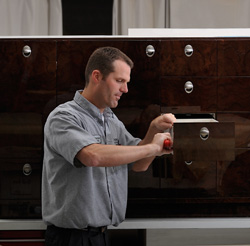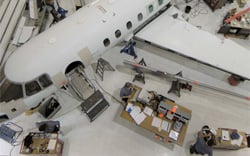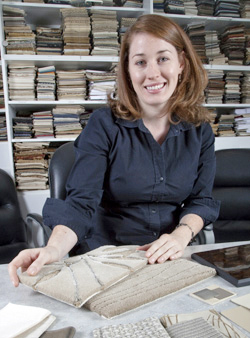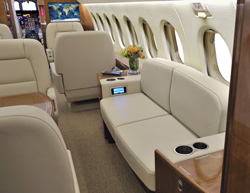Contributed by Interior Modification Reps. Nate Darlington and Matthew Schepers
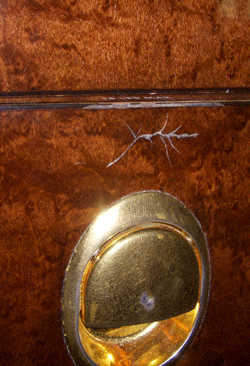
This drawer front veneer damage was caused by a strike that was out of alignment. This can be avoided with periodic door and drawer adjustments.
Maintaining an aircraft interior involves much more than keeping the carpets and seats clean. Functional interior items also require regular adjustment, and if done regularly can help an interior modification last longer.
Articulating chairs, executive tables, doors and cabinets will break or damage surrounding materials if they aren’t maintained. It takes very little time to make sure doors and drawers are properly adjusted and won’t puncture the cabinet veneer. Otherwise it takes multiple hours to repair and refinish the veneer.
When interior items become a nuisance, scheduling can become a last-minute addition to the workscope, which can extend downtime and increase costs beyond the budgeted expenses. Aircraft availability can also be affected if last-minute additions cause scheduling conflicts, or when there isn’t enough lead time to order necessary materials. As a general rule, larger aircraft should have interior projects planned at least six to eight weeks in advance. Smaller aircraft can be done with less lead time, about four to six weeks.
Operators tend to consider the condition of an interior about every six years or so (the typical lifespan of an interior). However, not all materials last that long without regular maintenance. The ideal way to schedule interior maintenance is to coordinate it with phased airframe maintenance events of similar downtimes. At Duncan Aviation, we call this approach “Phased Interior Maintenance.”
For example, maintenance events that require the removal and reinstallation of seats and floorboards are a prime opportunity to install carpet and replace softgoods. Nearly all aspects of an interior refurbishment can be divided among multiple maintenance events, which helps improve aircraft availability and keeps an interior looking new through the end of its functional lifespan.
Duncan Aviation works with operators to create custom interior maintenance schedules for Directors of Maintenance (DOMs) and their aircraft, free of cost or obligation. For advice on how to keep your aircraft interior looking new without the expense and downtime of a complete interior refurbishment, request a phased interior maintenance schedule at www.DuncanAviation.aero/interior.
Nate Darlington serves as an Interior Modifications Rep. at Duncan Aviation’s Battle Creek, Michigan facility, and began working in aviation in 2001. Matthew Schepers also serves as an Interior Modifications Rep. at Duncan Aviation’s Lincoln, Nebraska facility, and began working in aviation in 2005. Nate and Matthew both work with operators to plan phased interior maintenance schedules for their aircraft.



